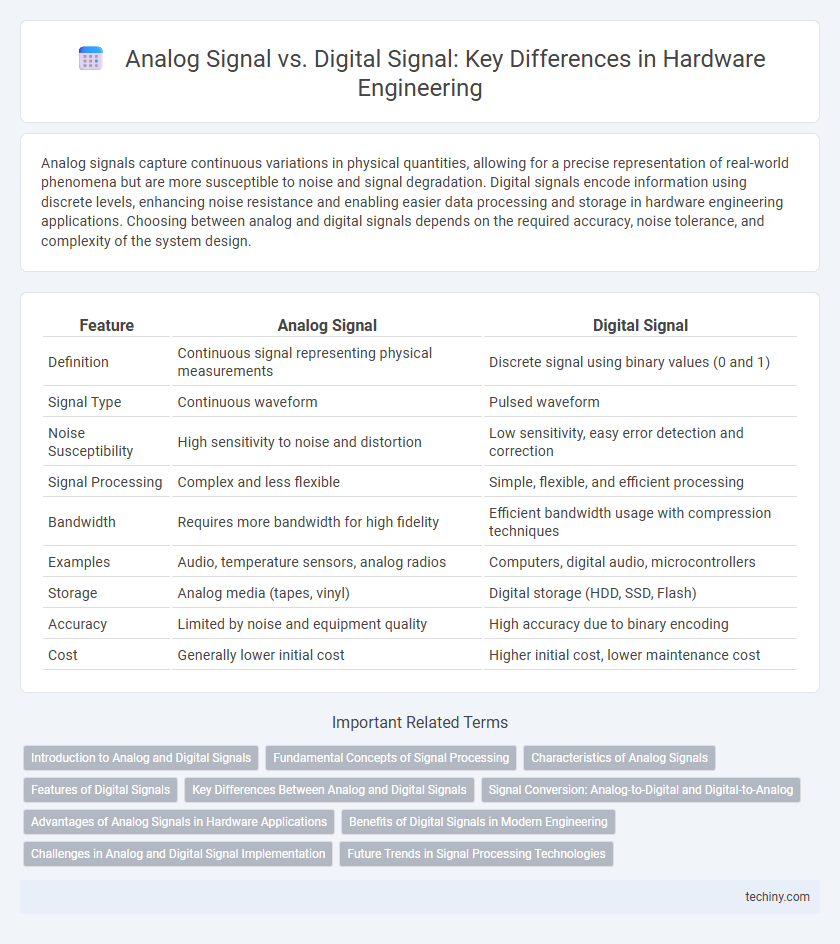Analog signals capture continuous variations in physical quantities, allowing for a precise representation of real-world phenomena but are more susceptible to noise and signal degradation. Digital signals encode information using discrete levels, enhancing noise resistance and enabling easier data processing and storage in hardware engineering applications. Choosing between analog and digital signals depends on the required accuracy, noise tolerance, and complexity of the system design.
Table of Comparison
| Feature | Analog Signal | Digital Signal |
|---|---|---|
| Definition | Continuous signal representing physical measurements | Discrete signal using binary values (0 and 1) |
| Signal Type | Continuous waveform | Pulsed waveform |
| Noise Susceptibility | High sensitivity to noise and distortion | Low sensitivity, easy error detection and correction |
| Signal Processing | Complex and less flexible | Simple, flexible, and efficient processing |
| Bandwidth | Requires more bandwidth for high fidelity | Efficient bandwidth usage with compression techniques |
| Examples | Audio, temperature sensors, analog radios | Computers, digital audio, microcontrollers |
| Storage | Analog media (tapes, vinyl) | Digital storage (HDD, SSD, Flash) |
| Accuracy | Limited by noise and equipment quality | High accuracy due to binary encoding |
| Cost | Generally lower initial cost | Higher initial cost, lower maintenance cost |
Introduction to Analog and Digital Signals
Analog signals represent continuous variations of physical quantities, enabling precise measurement of analog phenomena such as temperature and sound waves. Digital signals encode information using discrete binary values, allowing robust data transmission, error detection, and compatibility with modern digital systems. Understanding the fundamental difference between continuous analog data and discrete digital representation is essential for designing efficient hardware systems and signal processing applications.
Fundamental Concepts of Signal Processing
Analog signals continuously vary in amplitude and frequency, representing real-world phenomena with infinite resolution, while digital signals encode information in discrete binary values, enabling robust noise resistance and easier manipulation. Fundamental concepts in signal processing include sampling, quantization, and filtering, which convert analog signals into digital form and optimize their fidelity for computation and transmission. Understanding these differences is crucial for designing effective hardware systems that balance accuracy, efficiency, and cost.
Characteristics of Analog Signals
Analog signals exhibit continuous variation in amplitude and frequency, representing information with infinite resolution over time. These signals are susceptible to noise and distortion, which can degrade signal quality but allow for smooth and natural signal representation such as audio or temperature variations. Analog signal characteristics include their continuous waveform, infinite possible values within a range, and sensitivity to environmental interference affecting accuracy and fidelity.
Features of Digital Signals
Digital signals use discrete values, typically representing binary states such as 0 and 1, which enhances noise immunity and enables error detection and correction. Their precise timing and reproducibility allow for efficient data processing, storage, and transmission in modern hardware systems. Digital signals also support complex modulation schemes and integration with microprocessors, making them essential in advanced communication and control applications.
Key Differences Between Analog and Digital Signals
Analog signals represent continuous waveforms that vary smoothly over time, capturing real-world phenomena with infinite resolution, while digital signals use discrete binary values (0s and 1s) to encode information, allowing for easier signal processing and error correction. Analog signals are susceptible to noise and degradation, leading to signal distortion, whereas digital signals maintain integrity over longer distances due to robust noise immunity and regeneration techniques. The fundamental difference lies in analog's infinite amplitude variations versus digital's finite, quantized levels, impacting the design and performance of hardware systems.
Signal Conversion: Analog-to-Digital and Digital-to-Analog
Analog signals require precise Analog-to-Digital Converters (ADCs) to transform continuous waveforms into discrete digital data for processing. Digital-to-Analog Converters (DACs) perform the inverse operation by reconstructing analog signals from digital values, essential for interfacing with real-world sensors and actuators. High-resolution ADCs and DACs ensure signal integrity and minimize quantization errors during the conversion process in hardware engineering applications.
Advantages of Analog Signals in Hardware Applications
Analog signals provide continuous data representation, enabling precise measurement and smooth signal processing in hardware applications such as audio equipment and sensors. Their ability to capture finer details makes them ideal for real-time monitoring and control systems where subtle variations are crucial. Analog signals also typically require simpler circuitry, reducing design complexity and power consumption in analog hardware components.
Benefits of Digital Signals in Modern Engineering
Digital signals offer superior noise immunity, ensuring more accurate and reliable data transmission in complex hardware systems. Their ease of processing and compatibility with modern microprocessors enable enhanced flexibility and integration in engineering designs. Digital signals also facilitate efficient storage, compression, and error detection, making them indispensable in advanced communication and control systems.
Challenges in Analog and Digital Signal Implementation
Analog signal implementation faces challenges such as susceptibility to noise and signal degradation over long distances, requiring careful design of filters and amplification circuits. Digital signal processing encounters issues like quantization errors and limited resolution, demanding precise sampling rates and robust error correction methods. Both systems require trade-offs between accuracy, complexity, and power consumption to optimize performance in hardware engineering applications.
Future Trends in Signal Processing Technologies
Advancements in signal processing are driving the convergence of analog and digital technologies, with future trends emphasizing hybrid systems that leverage the precision of analog signals and the flexibility of digital processing. Emerging innovations include neuromorphic computing and quantum signal processors, which promise enhanced efficiency and real-time adaptability for complex analog-to-digital conversions. Enhanced machine learning integration further optimizes signal analysis, enabling smarter hardware designs that improve noise reduction and signal integrity in next-generation communication and sensing devices.
Analog signal vs Digital signal Infographic

 techiny.com
techiny.com